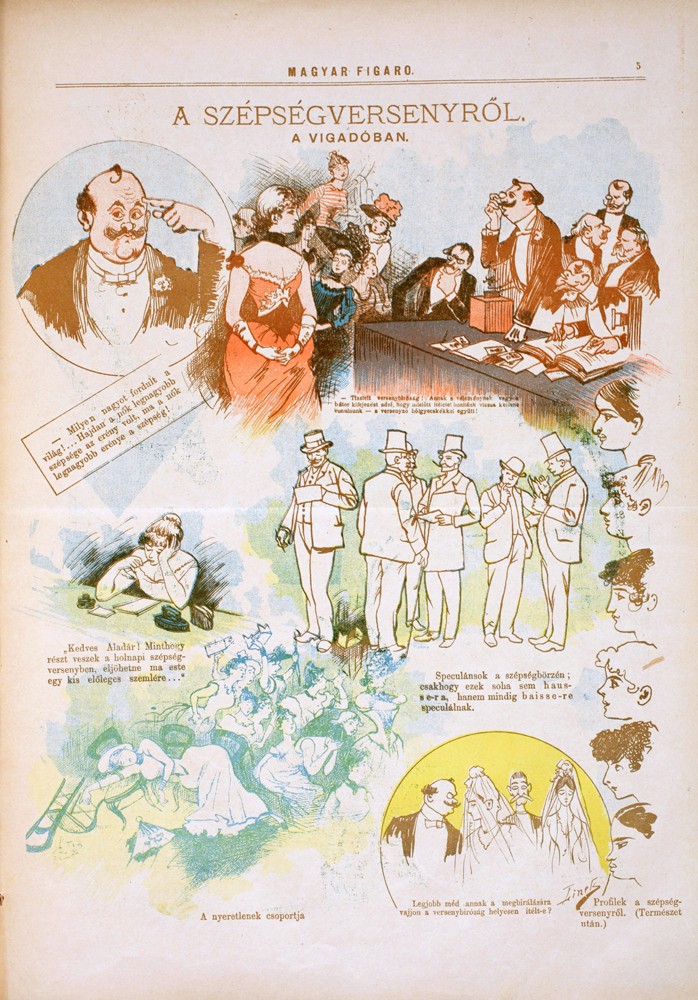
From Borsszem Jankó to Ludas Matyi – exhibition
 An exhibition entitled From Borsszem Jankó to Ludas Matyi will be opened on Floor 7 of National Széchényi Library. The exhibition presents the history of Hungarian humor magazines, which gave a true picture of the age in which they had been launched and reflected the political situation, atmosphere and social relations of their times and, by way of humor, they drew readers’ attention to anomalies and important issues. Caricatures published in such magazines were never without a meaningful reason. In addition to providing entertainment for readers, the caricatures were aimed at forming readers’ opinion about the social issues presented. Of course, this was done in harmony with the political trend of the magazine in which the given caricature was published.
An exhibition entitled From Borsszem Jankó to Ludas Matyi will be opened on Floor 7 of National Széchényi Library. The exhibition presents the history of Hungarian humor magazines, which gave a true picture of the age in which they had been launched and reflected the political situation, atmosphere and social relations of their times and, by way of humor, they drew readers’ attention to anomalies and important issues. Caricatures published in such magazines were never without a meaningful reason. In addition to providing entertainment for readers, the caricatures were aimed at forming readers’ opinion about the social issues presented. Of course, this was done in harmony with the political trend of the magazine in which the given caricature was published.
 The history of caricatures in Hungary is closely related to illustrated press gaining ground. Charivari–Dongó, the first Hungarian illustrated humor magazine was brought about by impetus from the Revolution of 1848 but a real breakthrough of the genre came only a decade later. Humor magazines published in the Age of Reconciliation (Üstökös, Bolond Miska, Borsszem Jankó, Ludas Matyi, Bolond Istók, etc.) had been organized around the controversy between 1848 and 1867 (independence versus reconciliation). In these newspapers, illustrations served rather as image additions to the lengthy anecdotal and humorous stories.
The history of caricatures in Hungary is closely related to illustrated press gaining ground. Charivari–Dongó, the first Hungarian illustrated humor magazine was brought about by impetus from the Revolution of 1848 but a real breakthrough of the genre came only a decade later. Humor magazines published in the Age of Reconciliation (Üstökös, Bolond Miska, Borsszem Jankó, Ludas Matyi, Bolond Istók, etc.) had been organized around the controversy between 1848 and 1867 (independence versus reconciliation). In these newspapers, illustrations served rather as image additions to the lengthy anecdotal and humorous stories.
By the turn of the century, texts became denser and, at the same time, image solutions were a lot more mature and much simpler. The new trends, including Art Nouveau and expressionism, gained ground in graphics as well. Rich decors, ample stylization, wave-like designs and the use of vivid colors were all characteristics of Art Nouveau appearing at the end of the 19th century. The style became the favorite form of expression of high-style Hungarian humor magazines at the turn of the century. (Magyar Figaró, Fidibusz, Flirt)
Expressionism, which started spreading at the beginning of the 20th century and was present in Hungarian caricatures until the end of the 1910s, gives a realistic picture of the atmosphere of the World War I era: anti-war feelings, disappointment and sympathy with those in need and with the fallen. (A Szamár, Április)
 Following World War I, humor magazines became less and less popular and several of them ceased to exist. In the period between the two World Wars, hardly any new humor magazine was launched in Hungary. After World War II, humor magazines abandoned the typographic traditions of the 19th century and they started representing new structures and completely new visual forms. (Ludas Matyi, Szabad Száj, Pesti Izé). Re-launched humor magazines were short-lived and, with the closure of the years of coalition, Hungarian readers had nothing else than Ludas Matyi, which functioned as a direct propaganda magazine of the Communist Party until the mid-1950s. Ludas Matyi’s humor style changed only in the 1960s when it became more and more reader-friendly.
Following World War I, humor magazines became less and less popular and several of them ceased to exist. In the period between the two World Wars, hardly any new humor magazine was launched in Hungary. After World War II, humor magazines abandoned the typographic traditions of the 19th century and they started representing new structures and completely new visual forms. (Ludas Matyi, Szabad Száj, Pesti Izé). Re-launched humor magazines were short-lived and, with the closure of the years of coalition, Hungarian readers had nothing else than Ludas Matyi, which functioned as a direct propaganda magazine of the Communist Party until the mid-1950s. Ludas Matyi’s humor style changed only in the 1960s when it became more and more reader-friendly.
The exhibition can be visited from April 1 to July 12, 2015 in the Catalogue Space of National Széchényi Library, on Floor 7, during the opening hours of the Library. Visitors who do not have a Reader Pass to NSZL can have a look at our temporary chamber exhibitions for a flat fee of HUF 400.



